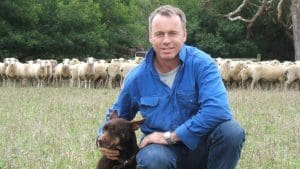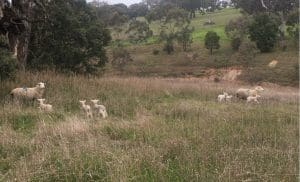
Pigeon Ponds sheep producer Tim Leeming. Picture – MLA.
VICTORIAN sheep producers Tim and Georgie Leeming are building precision into reproduction by shrinking pregnant ewe mob sizes and paddock sizes, and using natural shelter to maximise lamb survival.
Tim and Georgie Leeming run a self-replacing composite flock on 1530 hectares north of Coleraine at Pigeon Ponds in Victoria’s Western District.
They also run a sheep seed stock business, cattle and grow some cereal pasture crops, and have a strong focus on productivity and land development. Tim is regional chairman of the Southern Australia Meat Research Council. He has had a long involvement with Lifetime Ewe Management groups and Bestwool Bestlamb, and delivers qualified training in agriculture at Rural Industries Skills Training, Hamilton.
The Leeming ewe flock has been selected for genetic fat and muscle, aiming for a standard mature reference weight of about 62-63kg at condition score 3.
From a single cycle mating, his maternal composite ewes managed a 93.5 percent lamb survival to marking at 2-3 weeks from 3800 foetuses at scanning.
The lamb survival breakdown was 95.4pc in the ewes with singles, 91.7pc in those with twins and 86.1pc for his triplets.
The twinning ewes were run in mobs of 52 at a stocking rate of 7.5 ewes/ha, the single-lambing were in mobs of 360 at 11 ewes/ha and the triplet mothers were in groups of 12 ewes at about two ewes/ha in tree plantations alongside a creek. About 58pc of the ewes had twin lambs, 41pc had singles and the rest were triplets.
“Last year we were 87pc lamb survival over all lambings last year in the wettest winter on record for us, so we were really happy with those results last year,” he said.
“It’s about feed, it’s about the right paddock that gives you the best results.
“It’s about reducing mob sizes with multiples, providing at 1400-1500kgDM/ha Feed On Offer (FOO) at the point of lamb for those ewes,” Mr Leeming said.
“Singles are given half that amount of grass and we had 0.5pc mortality in the single ewes this year – at about 11-12 ewes to the hectare they are running on about 700kgDM/ha of grass.”
“As soon as we are past the danger period of dystocia, we open the gate and give the singles as much feed as they can handle.”
Mob sizes reduced dramatically
Mr Leeming said the flock had almost finished its second cycle lambing, with total lambing results finalised in September. Ewe mortality is running at 1.05pc from the June lambing and this may improve on the second lambing.
Mr Leeming said this year he maintained the same stocking rate as last year, but mob size with multiple-lambing ewes has been reduced significantly. He has used electric fencing reels to subdivided permanently fenced paddocks into 4-5 hectare areas.
“We’ve got 20 years of diaries that say smaller mobs, generally speaking, have better lamb survival, and we’ve selected paddocks that are very resilient as far as weather conditions; nice valleys with a lot of protection and shelter.
“The reason why we are doing single cycle lambing is to re-use all the best paddocks multiple times, rather than having to lamb in paddocks that are sub-optimal as far as shelter and lamb survival goes.”
For single cycle mating, the ewes are teased for two weeks with vasectomised rams and then joined for 16-17 days at about 2.5pc rams. The entire rams are then removed for 20 days and then the ewes are joined for another 17 days.
“We might be bringing in other ewes at the second and third joinings, but basically the first lot of ewes are joined three times and the rest of the ewes are joined at least twice.
“We just use the (pregnancy) scanner to identify the first (joining) lambing ewes and usually about 72-76pc of our ewes will get pregnant in that first cycle,” he said.
“All up over 7000 ewes we had 2.1pc dry ewes last year, we had 1.7pc dry ewes this year.
“Ewe lambs over the last two years have averaged over 150pc (scanned in lamb) with 10.1pc of the ewe lambs dry last year and 10.9pc dry in the ewe lambs this year.”
Time to dial up more twins

Ewes with triplets beside fenced creek areas.
Mr Leeming said the next step would be to “put a few more lambs” into his single-bearing ewes by expanding his formula into undeveloped areas on the farm and lifting average ewe condition score at conception to 3.3, instead of 3.
“I mean dialling up more twins – have more twin-bearing ewes.
“We’ve got to develop the pastures in a few of our valleys, by building up soil fertility and sub-dividing,” he said.
“We haven’t got a fertility issue, but we drive stocking rate hard.”
Mr Leeming said the downside is that this could mean more triplets, but he is confident they can manage triplet-bearing ewes.
“Having absolute privacy is so important for triplet-bearing ewes and not giving them too much high quality feed is also important.
“They don’t need much clover, because they end up blowing up – you can kill them with kindness.”
Mr Leeming said shelter, stocking rate and mob size are paramount for ewes with lighter triplet lambs.
“A long skinny tree plantation or a creek plantation is perfect, because they can stretch out and have their own little nest; it seems to be working well.”
Farmers can fence riparian areas off a bit wider, put in gates and utilise them as triplet lambing areas, he said. The Leemings’ dozen triplet bearing ewes trotted out of their plantation with 31 lambs.
“We didn’t go around them at all and we didn’t lose any ewes – privacy, plenty of feed and the best shelter you could possibly imagine part from putting them in a shed – it was awesome.”
Mr Leeming said recording lambing data from the different paddocks enabled underperforming areas to be dropped for future lambings or the stocking rate can be adjusted.
“A lot of people dilute a lot of that information on their farms by boxing mobs up for lamb marking.
“We count all of the lambs out of these cells every time we put mobs together for marking.”
As soon as ewes have had their lambs they are destocked out of their lambing zones and the areas are treated with urea and Progibb to boost pasture growth for the next lambing.
“There is a lot of strategy and planning that goes into it; essentially it is just precision.
“A lot of it is low-cost, it’s just being organised.””
Mr Leeming said croppers used GPS, controlled traffic, deep-banding fertilisers and a range of chemicals to plant crops and control weeds, while some in the sheep industry had only used precision principles with feeding and pregnancy scanning.
“When we get to lambing all our precision goes out the door – at the time of our harvest.
“It’s the equivalent of croppers using all their precision technology and then when harvest arrives they wheel out an old header with worn out screens and blow 30pc of their yield on the ground,” he said.
“It’s about tighter little lambings in your best country with the best feed for the right animal at the right time.”
Mr Leeming said some lamb producers chase reproduction, but don’t maximise survival.
“I’m pretty confident that we will be weaning around 140pc lambs from our mature ewes, but hopefully not losing any more than 9pc of our foetuses.
“Our ewe mortality at the first lambing is under one percent and we hope to maintain that through our second lambing,” he said.
“You should only put foetuses in ewes when you can manage the foetuses you’ve got.”

Tim us to be congratulated on what is an incredible achievement. If I apply Tim’s survival rates to Multimeat ewes, then 185 percent marking rates could be obtained and this was achieved on two trial sites. We are a long way off reaching the maximum levels of lamb production per hectare since multiple-rearing ewes are so much more efficient at converting grass into meat than single-rearing ewes.